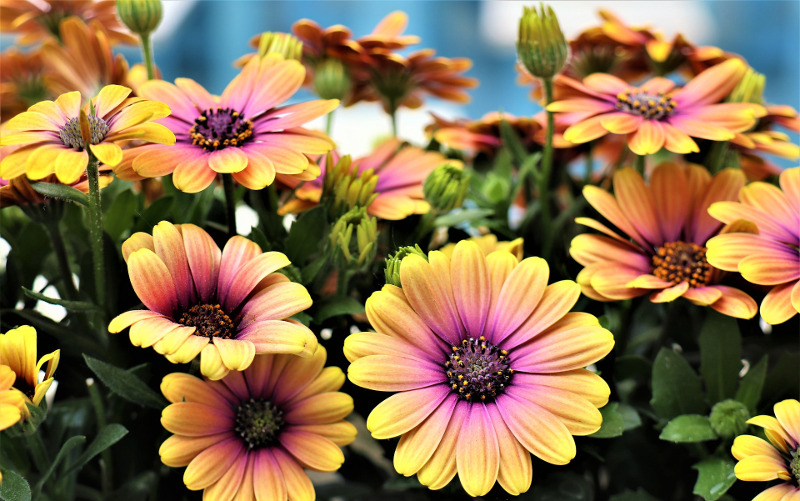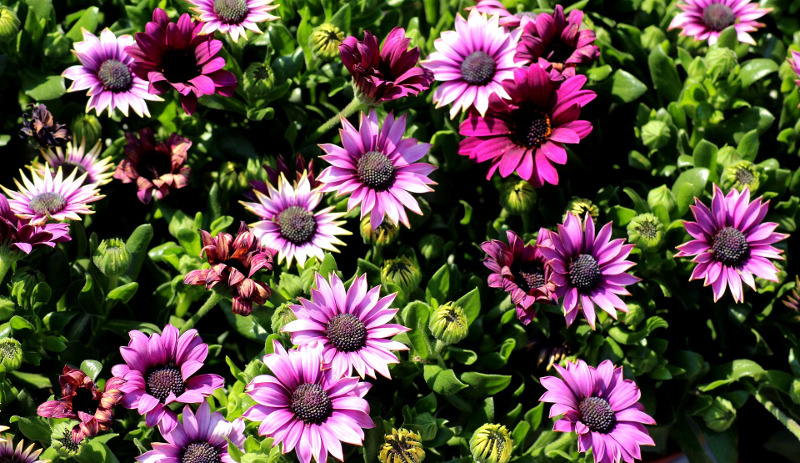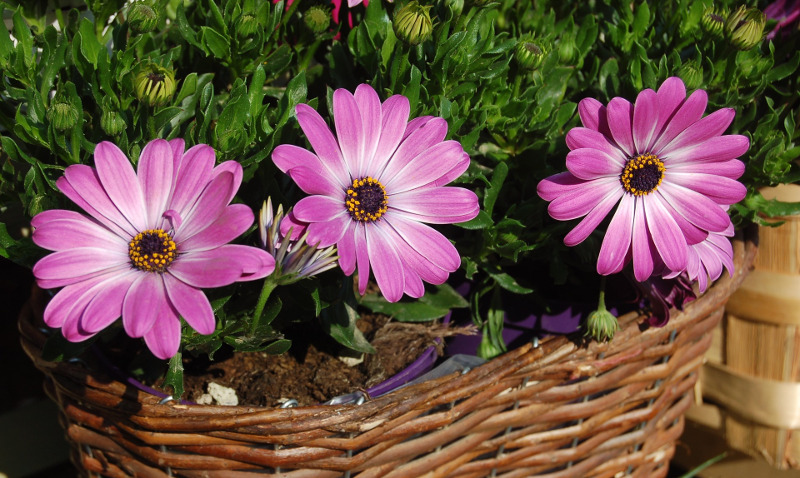The African Daisy (Osteospermum spp.), is a genus of flowering plants belonging to the Calenduleae, one of the smaller groups of the sunflower/daisy family Asteraceae. The scientific name is derived from the Greek osteon (bone) and Latin spermum (seed). It has been given several common names: African daisy, South African daisy, Cape daisy and blue-eyed daisy. This plant looks like the common daisy but is more vibrant in its display.
Blooms have single or multi-colored centers with petals that can be fringed, double or spoon shaped. Bold colors of pink, purple, orange, yellow, white or bi-color, this flower grows 1-3 feet tall and 1-2 feet wide. Best planted in full sun, African Daisy is hardy in USDA zones 9-11. Gardeners love these plants for garden beds, borders, or containers.

Planting African Daisy
This flower should be planted in the spring when the threat of frost has passed. African Daisies have a fast growth rate and blooming will occur about 2 months after planting. Growing 1-3 feet tall and 1-2 feet wide, it is best to space each plant at least 12 inches apart. Planted in full sun and in soil with good drainage, this flower is typically low-maintenance.
Water consistently until the roots are established. Fertilize regularly throughout the growing season. Deadhead the spent blooms to encourage reblooming.
Watering African Daisy
Once established, African Daisies are somewhat drought tolerant. For best results, water the flower with one inch of moisture per week. The goal is to keep the soil evenly moist. Careful of overwatering, as soggy soil can lead to root rot. During extreme heat or drought conditions, the African Daisy’s growth can slow down or even go dormant. Additional water may be needed.

Fertilizing African Daisy
For healthy growth and optimal blooming, African Daisies like a lot of nourishment and feeding. Upon planting, apply a slow-release fertilizer. Throughout the growing season, apply a monthly application of fertilizer for flowering plants. Apply at the base of the plant and water well after each application. Careful of too much nitrogen which can cause excess foliage growth with little blooming.
Pruning African Daisy
During the early growing season, pinch the young plant two or three times to support strong stem growth and a bushier plant. Do this before flower buds appear. To encourage continued blooming, deadhead your African Daisy regularly. If this is not done, it can cause the plant to go to seed and blooming will stop. By midsummer, this plant can become leggy. A light trim can shape the plant and encourage fresh new growth.

Caring For African Daisy in Pots
African Daisies are typically planted with companion plants. With that said, spacing can be a bit less than the recommended 12 inches between plants. Plant African Daisies in a container that has good drainage holes. Use a well-draining potting mix and plan on frequent watering. Place the pot in a location that will get full sun each day. Because containers are watered more often, nutrients will leach out much faster. Frequent fertilizing is encouraged.

Winter Care for African Daisy
African Daisies do not overwinter well and will die off with the first hard frost. Prior to a hard frost, you can bring this container plant indoors and store it in a room that is sheltered from the freezing temperatures. If possible, the room should offer bright light. Winter is a rest time for African Daisies, so do not fertilize and water sparingly.
When spring arrives, cut the plant back and put it outside for a few hours each day. Avoid direct sun during this time. Once the threat of frost is gone, the plant can remain outdoors.
African Daisy Scientific Classification
| Kingdom: | Plantae |
| Clade: | Tracheophytes |
| Clade: | Angiosperms |
| Clade: | Eudicots |
| Clade: | Asterids |
| Order: | Asterales |
| Family: | Asteraceae |
| Sub Family: | Asteroideae |
| Supertribe: | Asterodae |
| Tribe: | Calenduleae |
| Genus: | Osteospermum |
African Daisies For Sale
Common African Daisy Care Questions
Do African Daisies Come Back Every Year?
In USDA Hardiness Zones 10 and 11, African Daisies (Osteospermum) are considered perennials, but in any other zone, they're grown mainly as annuals, as they're not fans of colder temperatures, at all.
Do African Daisies Need Full Sun?
African Daisies will thrive in full sun. They can tolerate a little shade, but they will flower less profusely.
Are African Daisies Drought Tolerant?
African Daisies are drought-tolerant, and soil that is too wet can be detrimental.
Have a question about African Daisy? Fill out the form below and we will try and get back to your question as soon as possible. We may even feature your question on this article to help other gardeners!
 |
Author Chris Link - Published 09-08-2021 |
